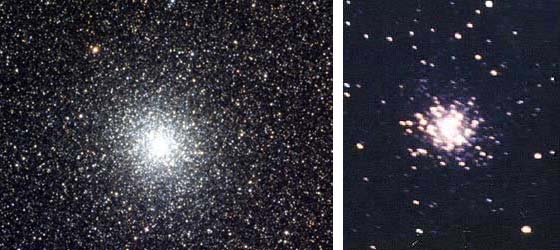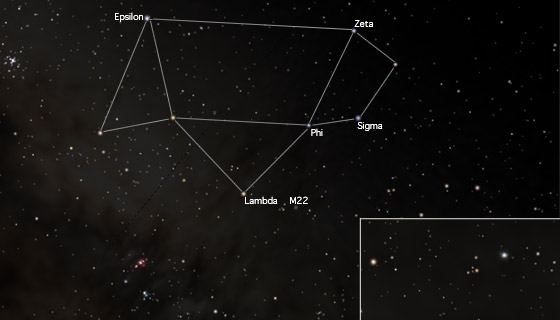
M22Basic information about M22. M22 is a globular cluster (class VII) in Sagittarius, also known as NGC 6656. The position is right ascension 18:36.4, declination -23:54 (best viewed from the Southern Hemisphere but still visible to most Northern observers). The distance is 10,400 light years, and the apparent magnitude is 5.1 (visual). The angular size 32 arc minutes (the size of the full Moon, true diameter 97 light years). This cluster is surprisingly bright, only Omega Centauri and 47 Tucanae are brighter (yes, its brighter than M13), so its easy to see with binoculars and is bright enough to be easily seen with the naked eye if the sky is dark. There are estimates of 70,000 stars in the cluster. Its generally thought that it was discovered by Abraham Ihle in 1665 but there may have been earlier sitings. The left photo above is taken at a professional observatory and the one on the right was one I took through a 30cm f/5 reflector. I used Fuji P1600D professional slide film push processed to 3200 asa. The exposure time was 4 minutes. OK, the guiding wasn't great, was it! 
To find M22 you need find the constellation Sagittarius. This constellation is often described as the teapot. You can see this shape (upside down for southern observers) in the diagram above. Even if you can't see a teapot, the quadrilateral and triangle shapes on either side are easy to find. If you have trouble finding Sagittarius, try starting from Scorpius and find Sagittarius near the scorpion's sting. The cluster on the left of the map near the top is M7 which is in Scorpius. After finding these shapes follow the line from Zeta to Phi to Lambda, then use the smaller chart to find M22, about 2.5° away from Lambda. Notice the small groupings of stars near the globular which should make its location easier. Remember that the small chart is probably about half the field of most binoculars. |
![[Up]](../XuShared/Up2B.jpeg)